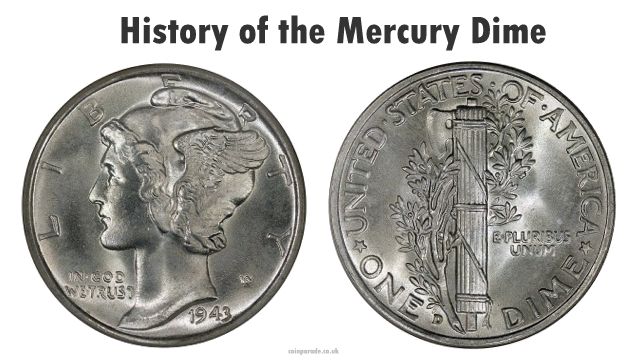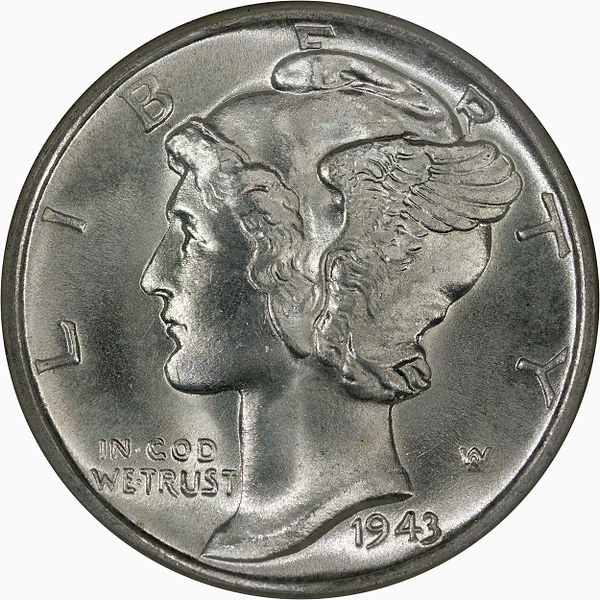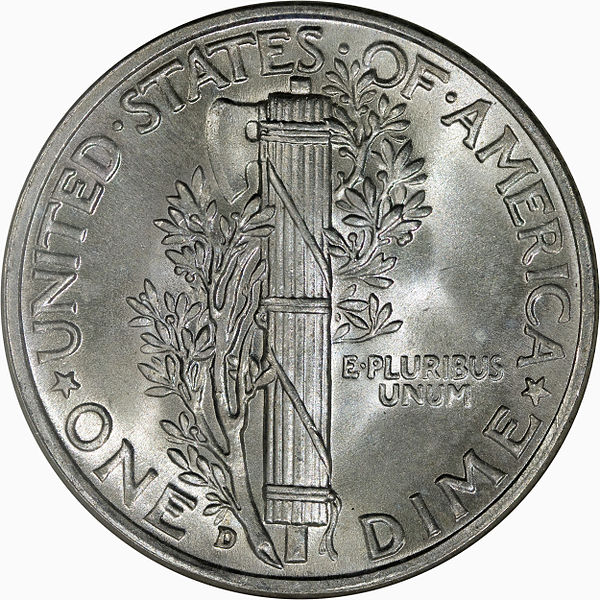
The Mercury Dime was minted from 1916 through 1945. The coin is actually named a Winged Liberty Dime, but as the image of Liberty wearing a cap with wings looked very much like the Roman God Mercury it is better known as a Mercury Dime.
by Keith Scott
The year was 1915 and there was a movement afoot to change the remainder of American coinage. With the changes to the $10 eagle, $20 double eagle, the cent and nickel, it was now time for changes to the dime, quarter and half dollar. Under 1890 law, changes could not be made to a coin design without approval from congress more frequently than every 25 years. The Barber coinage (dime, quarter and half dollar) was to reach that mark in 1916 and the mint wasted no time in making the changes, in fact starting the process before 1916.
In 1915, US Mint Director Robert W. Woolley offered the opportunity to three noted sculptors, Adolph A Weinman, Albin Polasek and Herman A. MacNeil to prepare designs for three silver coins. Outside artists, not chief engraver Charles Barber, supplied designs for the previous six changes and Woolley felt this was a great option. By 1916, Barber was 75 years old but had a track record of being hostile to outside artists designing coins he thought he should be designing. With three new designs, all replacing coins Barber himself had designed, it could have gotten unpleasant. The records suggest Barber was on his best behavior. In this case it seems he just stepped aside and let his assistant George T. Morgan, who had designed the Morgan dollar, do all the work. Maybe Barber finally just gave up or was too old too fight anymore or just recognized the beauty in the designs. Barber died in February 1917 and was replaced by Morgan.
It is assumed that Woolley intended to award a different coin to each person. It may not have been planned this way, but Weinman ended up getting two of his designs as the winning designs. One being what would become known as the Walking Liberty Half and the Mercury Dime. MacNeil won the design for the quarter with Polasek getting shut out. Adolph A. Weinman was born in Germany and came to the US at the age of 10 in 1880. He was a student of well known sculptor Augustus Saint-Gaudens. Saint-Gaudens is also credited with some truly outstanding coin designs. By 1915 when the design process began, Weinman was widely celebrated as one of the nation’s best sculptors.
The design of the Mercury dime is that of a “Winged Liberty” and is based on a bust that Weinman did in 1913 of Elsie Kachel Stevens, wife of well-known poet Wallace Stevens, who happened to be tenants of a New York City apartment building owned by Weinman. The winged cap was to symbolize freedom of thought.

The reverse of the coin depicts the fasces, an ancient symbol of authority, with a battle-ax at the top to represent preparedness and an olive branch beside it to signify love and peace and authority.
Production and release of the new dimes was delayed until later in the year of 1916 as the dies were not quite ready. The Philadelphia and San Francisco mint produced Barber dimes much of 1916 to meet demand while Denver ceased producing Barber dimes in 1914. Once the dies were complete, production began with both Philadelphia and San Francisco cranking out millions of dimes. Denver though produced a mere 264,000 making the 1916-D an instant rarity.
Shortly after the dime began circulating, many people began calling it a “Mercury dime” due to the wings on the cap. Mercury is the Roman god of trade, property and wealth as well as messenger to the other gods. The hat, called a Petasus, is similar to that worn my messengers during the time when Mercury was worshipped. Mercury gained his speed from his wings. Although not the original and intended name for the new time, the term Mercury stuck and that is what it is known as today.

The Mercury dime served Americans through two world wars ending its run in 1945. With the death of Franklin Delano Roosevelt in 1945, there was a strong movement to honor the president and in 1946 the Roosevelt dime began production and is still used today.
Collectibility
General
The Mercury dime is a wonderful coin for both experienced and beginning collectors and is the most popular collected series in its denomination. A complete set including all keys can be had for under $1500.00 but the keys will be in very bad condition. A nicer set with all coins graded at least G4 including keys can cost upwards of $2000.00 or more. If you want to establish a year collection, you can avoid the big cost of the 1916-D but you still will need to shell out $50 or more for a 1921 dated dime. Both mints, P or D (San Francisco did not produce any) are considered keys. All other dates should be easily obtained.
Many people collect what is called a short set consisting of all mints and years from 1934 to 1945 or 1941 to 1945. A short set of BU specimens from 1941 is 1945 is quite attractive. Taking the three keys (discussed in a bit) out of the equation, all dates and mints can be had for under $10.00 in G4 condition with the majority of them under $3.00. Most coins after 1940 can be had for under $1.00 in pretty decent grades.
As with many coins of the times, Philadelphia was the main producer of coins while Denver and San Francisco were generally much lower than Philadelphia. For the entire series, Philadelphia produced 65.9% of all dimes, Denver produced 17.8% of all dimes while San Francisco produced 16.3%, clearly making mint marked dimes a little tougher to get.
Production totals exceed 50 million on 6 times prior to 1940 but never going over 67 million (1939). This totals far exceeded production of the Barber dime but pail in comparison to the later years of the Mercury dime. In 1941 production totals skyrocketed with Philadelphia producing 175 million dimes. For the last four years of production, totals never fell below 159 million. A total of 2.6 billion dimes were produced with over half, 56% being produced during the last 5 years with the last four coinciding with WWII.
An amazing statistic considering the Mercury dime was in production for 30 years. Of course many of those years were during the depression where coin production was low for all denominations.
When grading Mercury dimes, the grading criteria changes somewhat in Mint State coins. Coins what are fully struck have what is called Full Split Bands (FSB). This is in reference to the fasces where there are clear and fully defined horizontal bands with separation between them. Mint State coins with this definition will command premiums over their counterparts without this designation.
Key/Semi Key Dates
Clearly, from a non-variety perspective, the 1916-D is the toughest and most expensive coin to obtain. Although not the rarest, is perhaps the most famous dime in U.S history. Typically, first year issues are heavily hoarded and collected by the public which typically preserves many coins. Not so with the 1916-d as its rarity initially went unnoticed. With millions of coins coming from Philadelphia and San Francisco, the public had not noticed that very few had the Denver mint mark. This is easily determined by the fact that so many 1916-D dimes are available in such low grades as so many of them circulated for more than 30 years. Another clear example is the stunning amount of 1916-D dimes discovered in the “New York Subway Hoard”. The collectors of this hoard did not begin collecting until the 1940’s. More than 25 years after the release of the 1916-D yet 251 examples of this special coin were in the hoard.
Coins in the lowest grade of FA2 or G3 will cost upwards of $500.00 and the prices only go up from there. A VG8 is typically priced at $1300.00. While this coin is indeed pricey, it is readily available from many dealers.
The second key of the series is the 1921-D followed closely by the 1921-P. Both of these coins had mintages of just over 1 million. Both of these coins will cost over $50 for a G/VG grade. From here, the cost of individual coins drops dramatically as the next semi-keys are 1926-S and 1931-D. Both of these can be had for under $10.00 in low grades.
A note about low grades: While you can obtain these rarities in low grades, eye appeal is NOT their strong point. Coins in AG-G condition typically show the date/partial date and mint. It is generally tough to make out details in the coins as they are well worn. I quote prices in G4 as to give you an idea of what minimum prices are for keys and semi-keys. Prime examples in the coins noted above can run into the 10’s of thousands of dollars. While the 1945-P coin is readily available in all grades, FSB specimens are extremely rare. Many common dates of the 1940’s have dozens of coins graded in the MS-67 range while the 1945-P currently has only 3 certified PCGS coins.
Errors
Perhaps the best know error in the Mercury series is the 1942/1 overdate. These were produced at both Denver and Philadelphia with the Philadelphia variety having popularity near the 1916-D. In the lowest grades these coins will cost over $500.00 and will be hard to distinguish the error. It would be suggested to purchase these through a well known dealer and/or buying only certified coins of this error.
The other well known variety occurred in 1945 and that was a change in the size of the mint mark on San Francisco coins. Called “Micro S”, many 1945 dated coins have a smaller “S” mint mark and sell for a slight premium over regular “S” coins.
Proofs
Proof Mercury dimes are quite beautiful. They were only produced for seven years, from 1936 to 1942. A complete set in PR-65 condition would cost around $5000.00
Vital Statistics Summary/Key Coin Info
- Designed by: Adolph A. Weinman
- Issue dates: 1916-1945
- Composition: 0.900 part silver, 0.100 part copper
- Diameter: 17.9 mm Weight: 38.58 grains
- Edge: Reeded
- Business strike mintage: 2,677,153,880
- Proof mintage: 78,648
Keith Scott has been a collector for over 30 years. His website has US coins for sale. He also writes Coin Collecting Articles for fun. Visit his websites for a history of US coins, metal market updates and news about your favorite coins.








